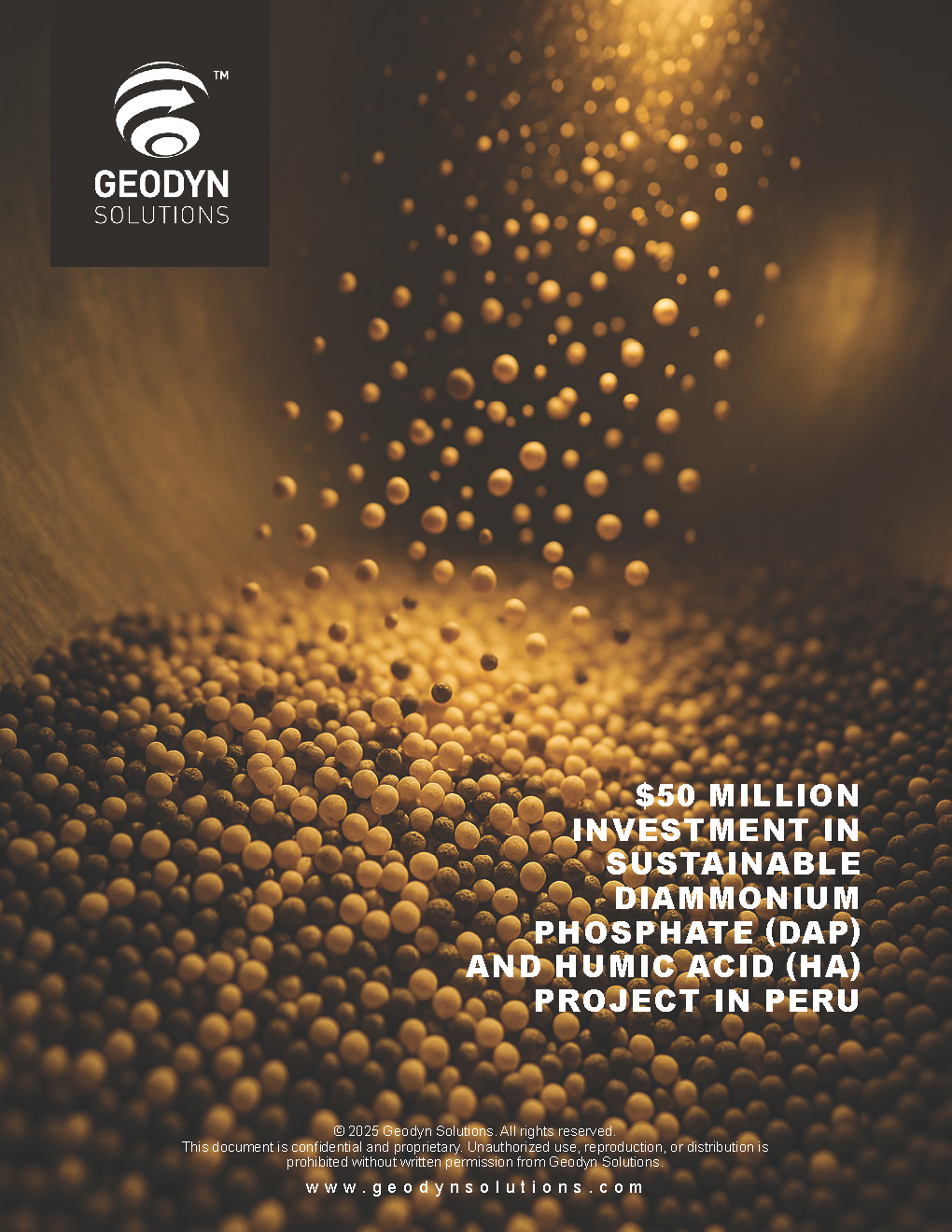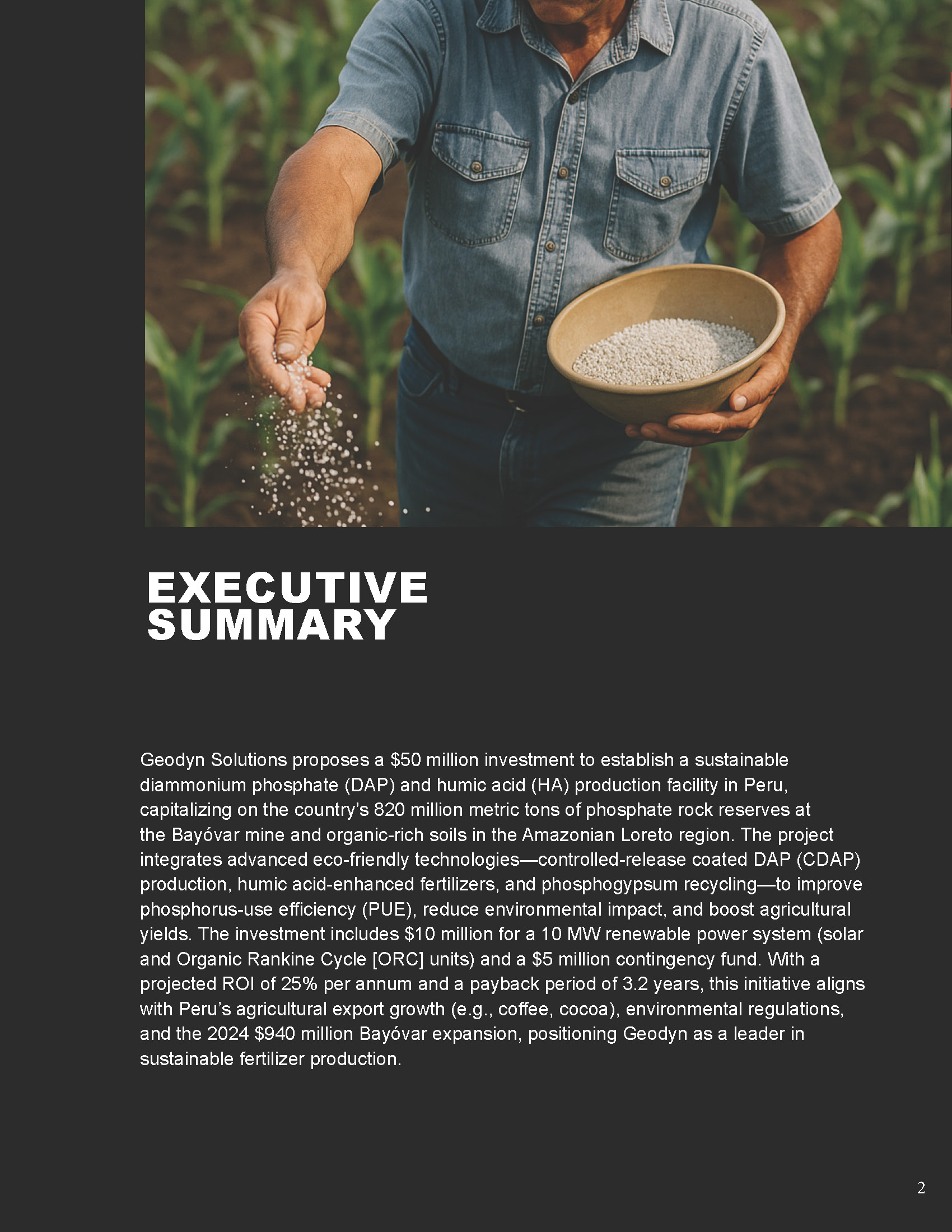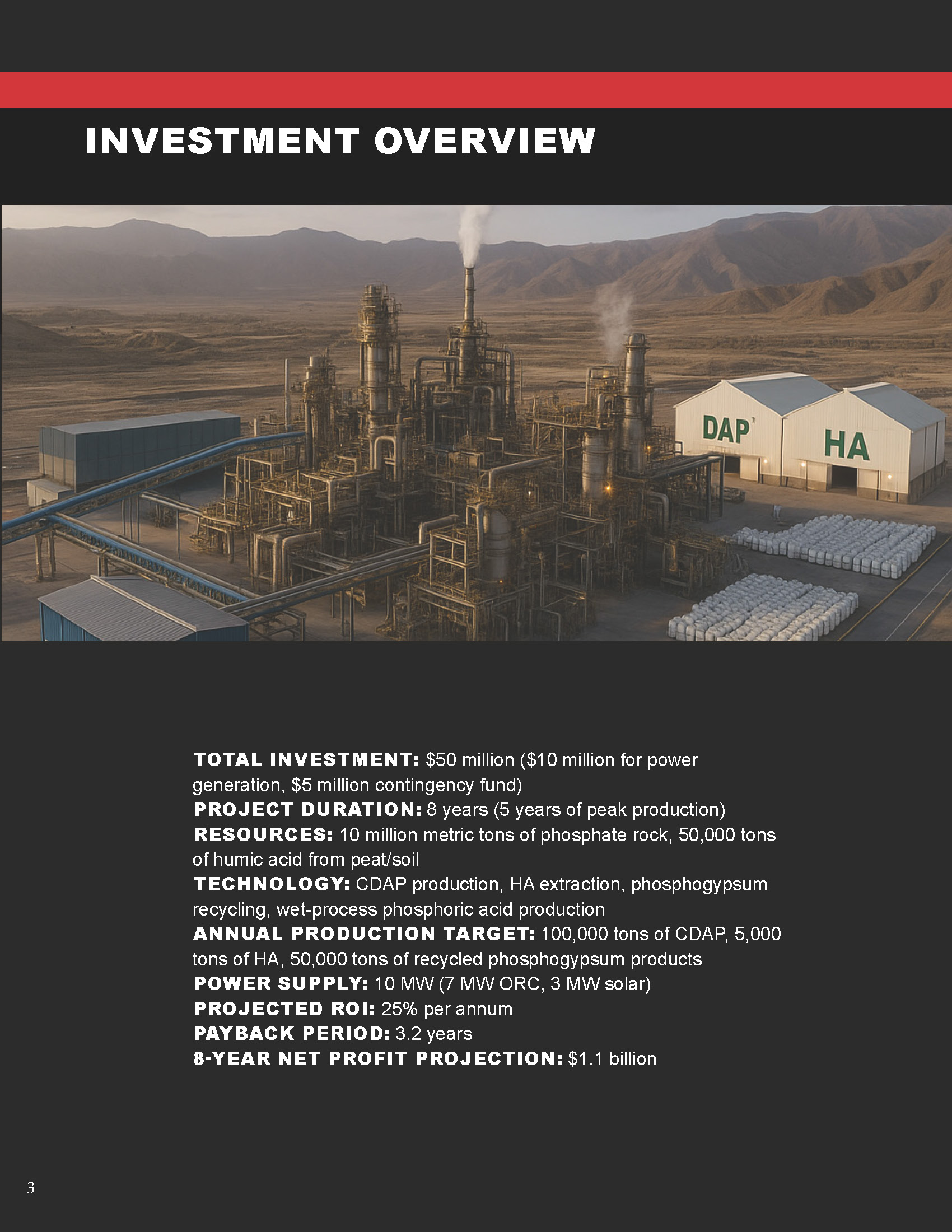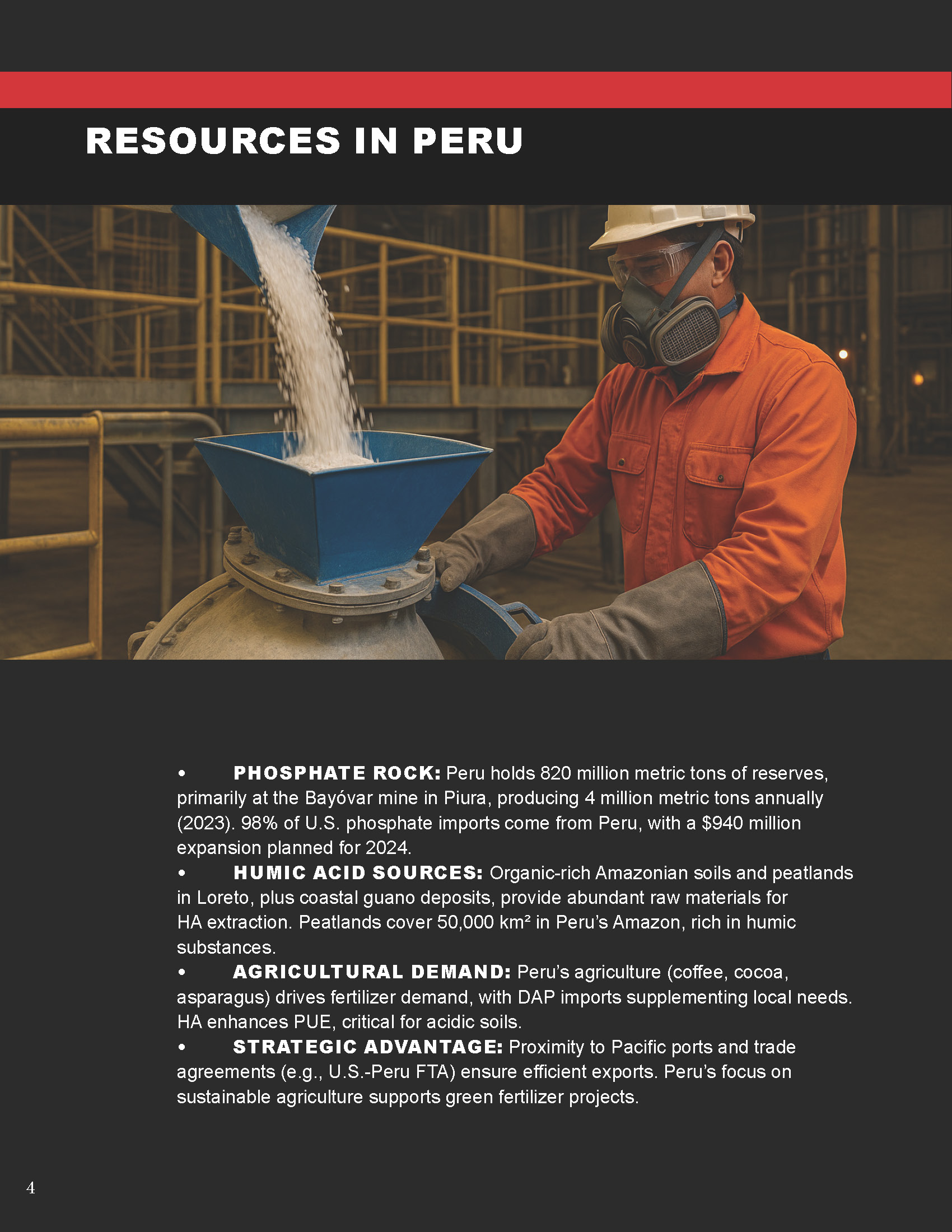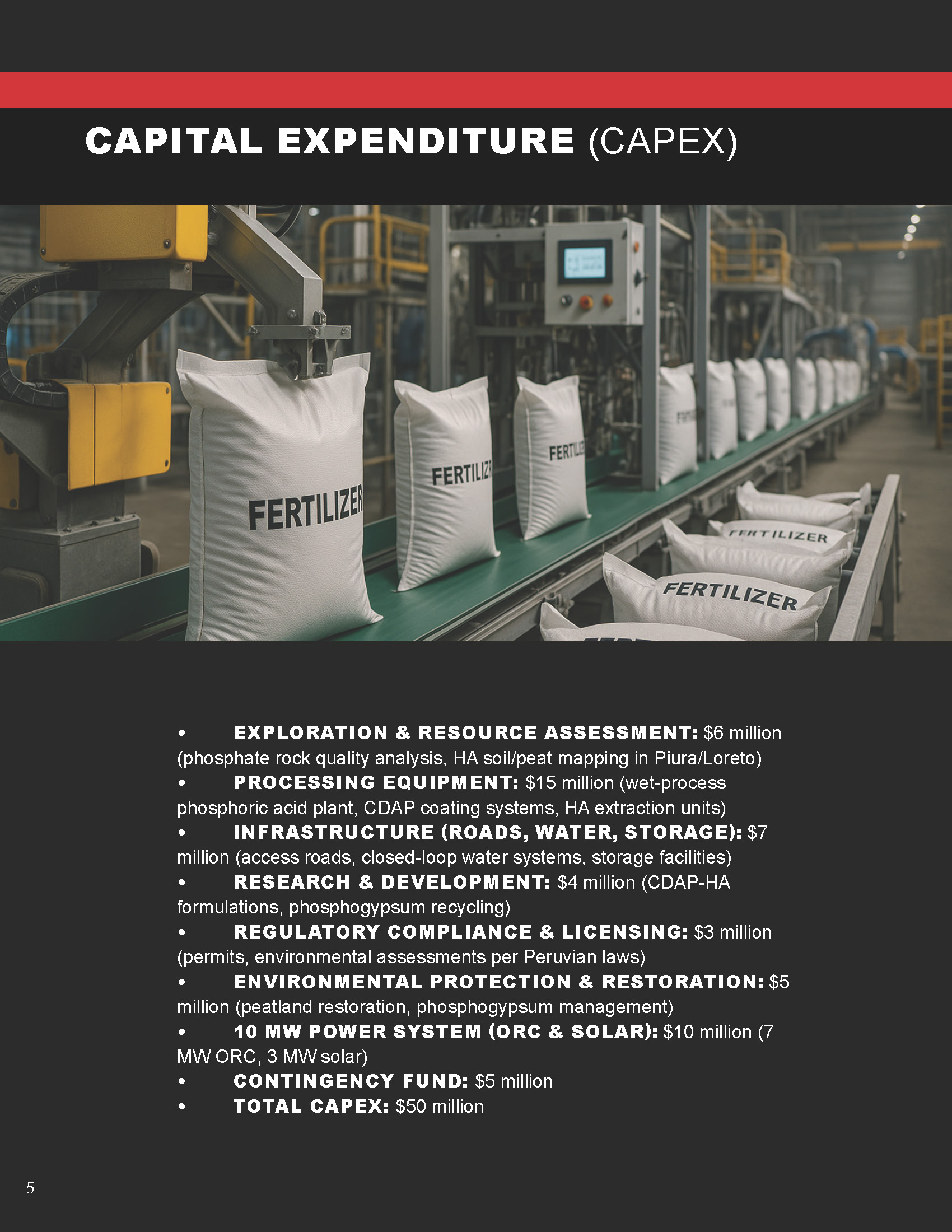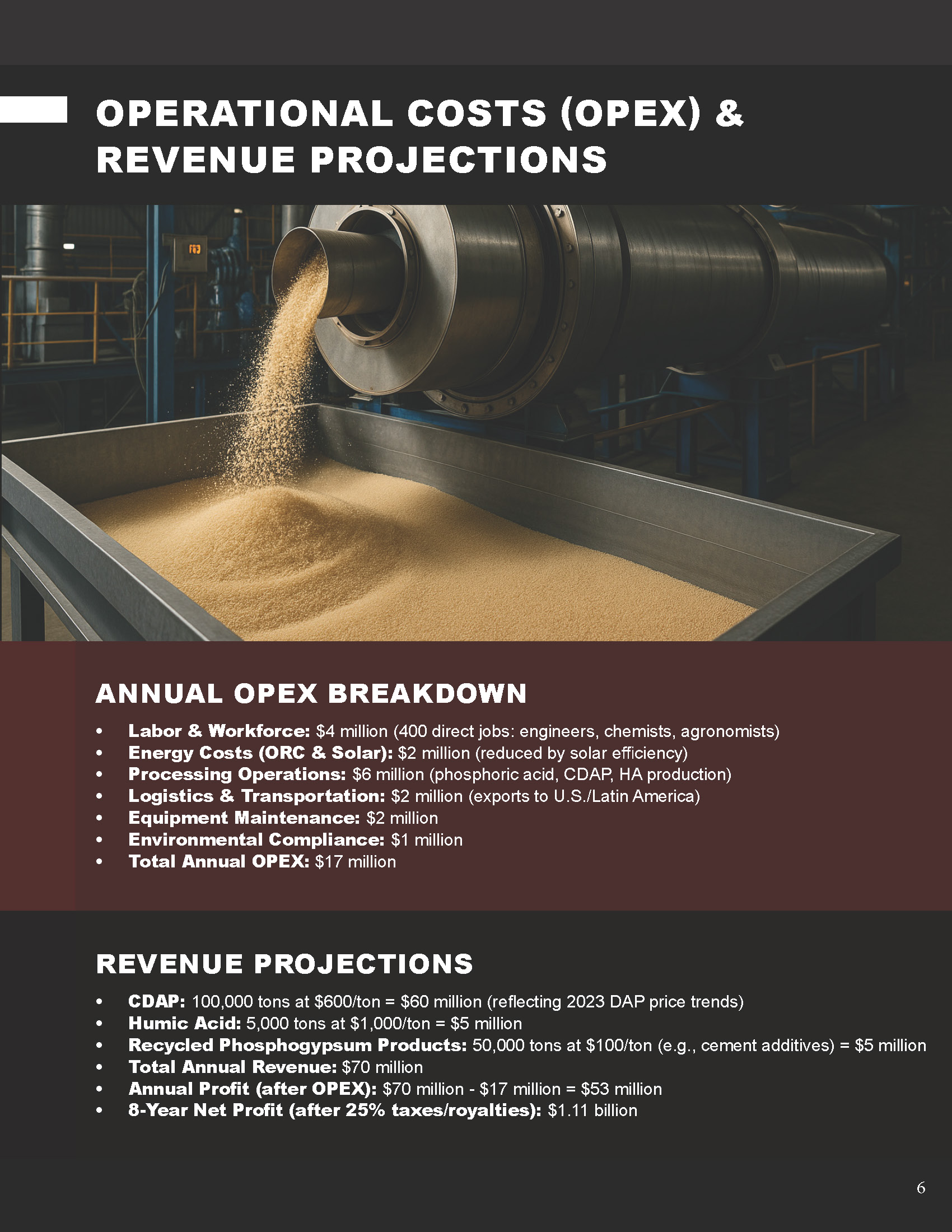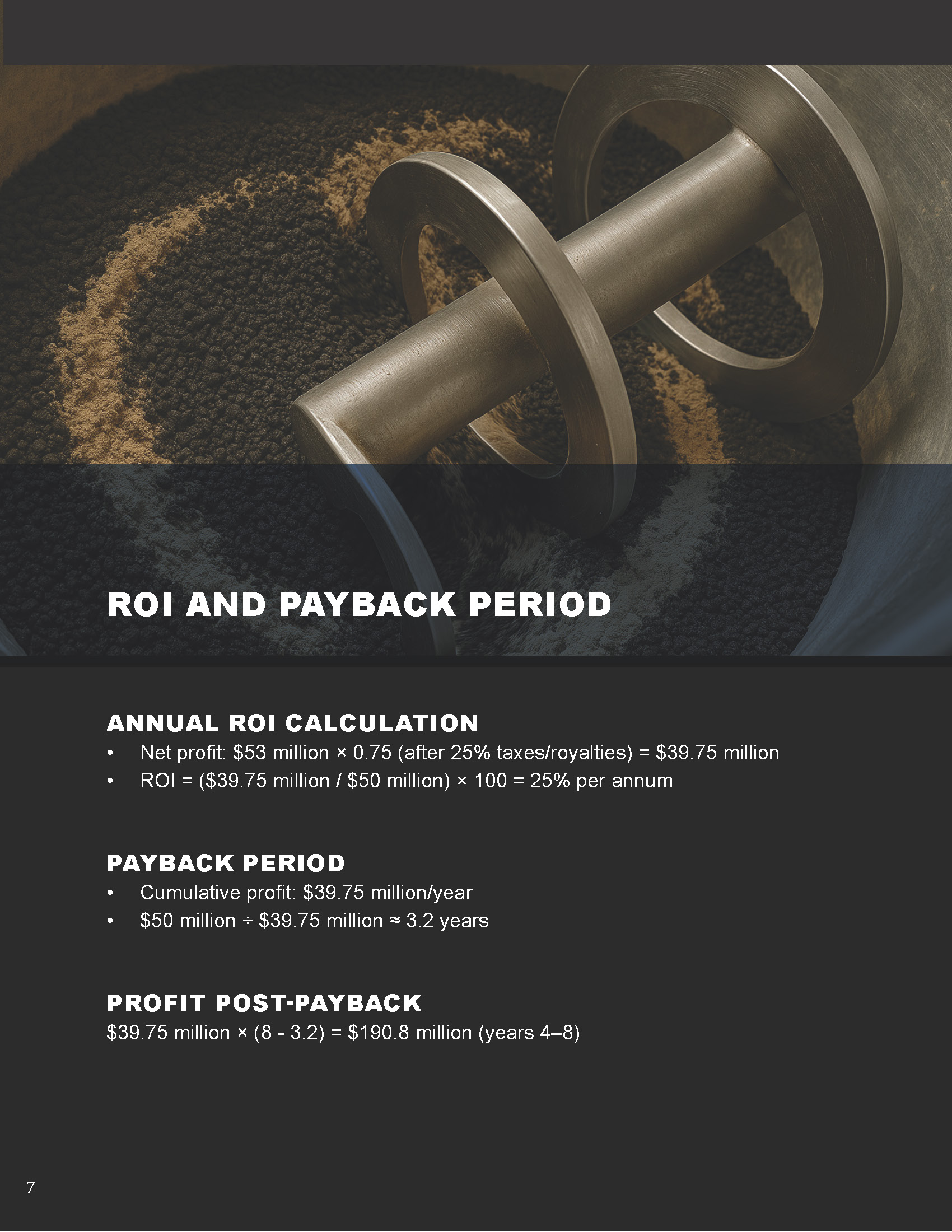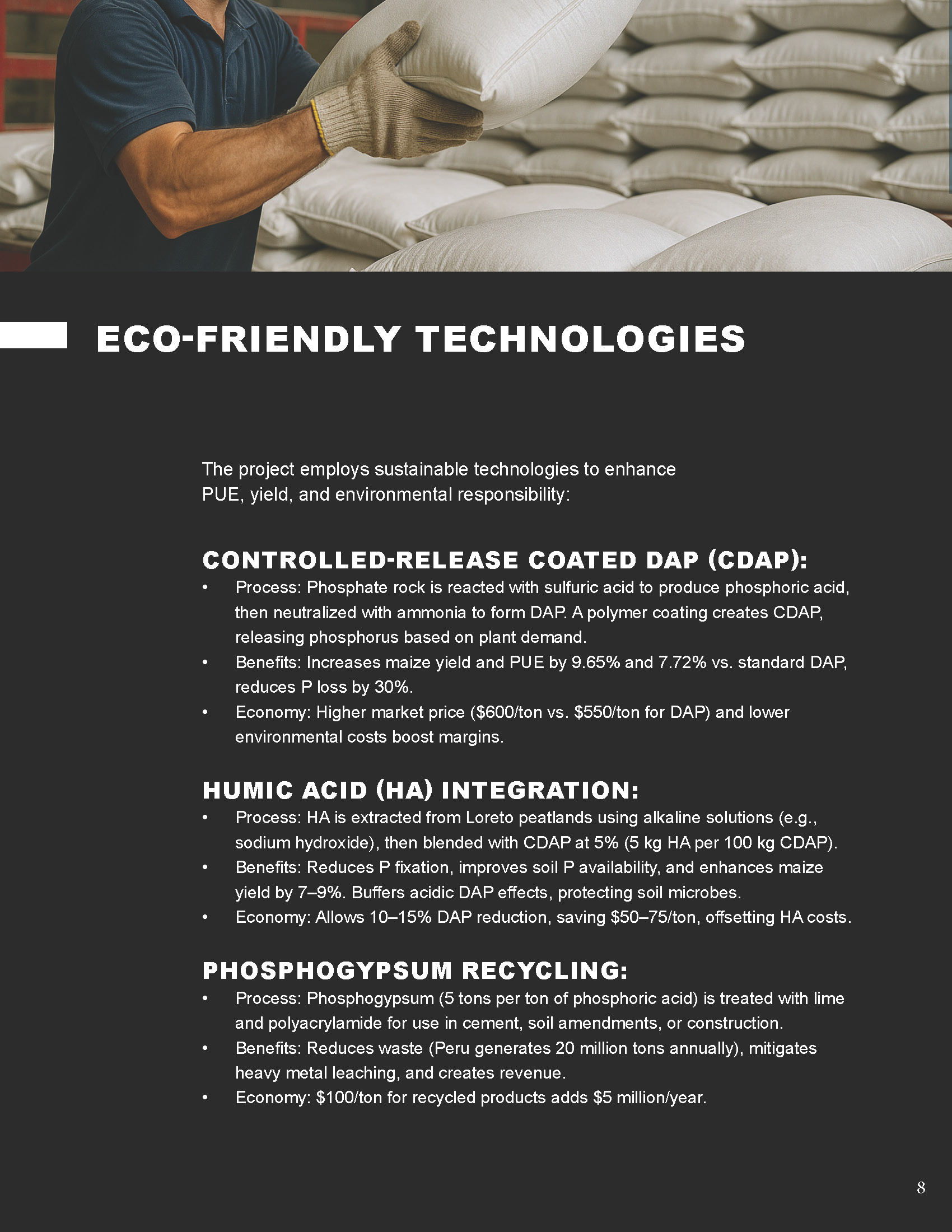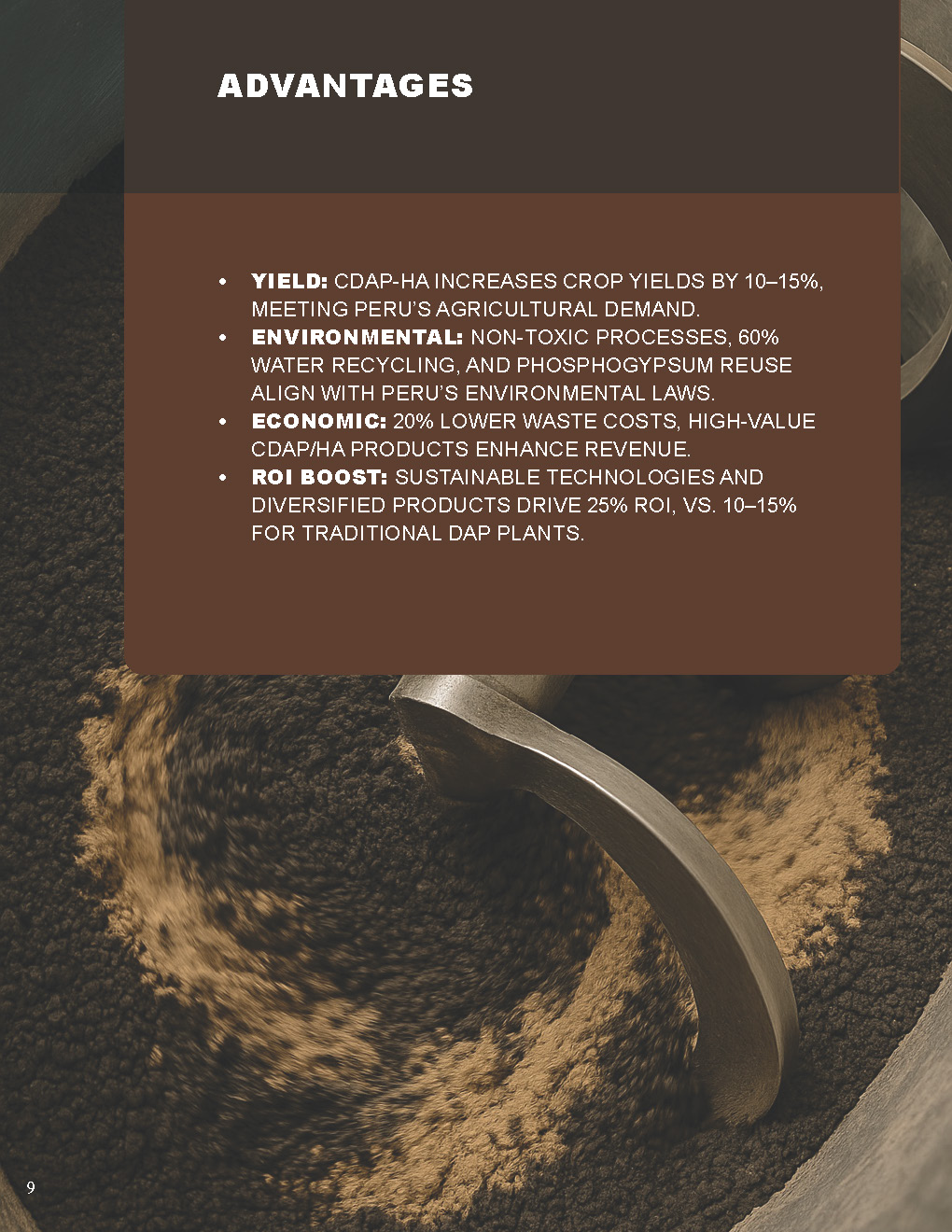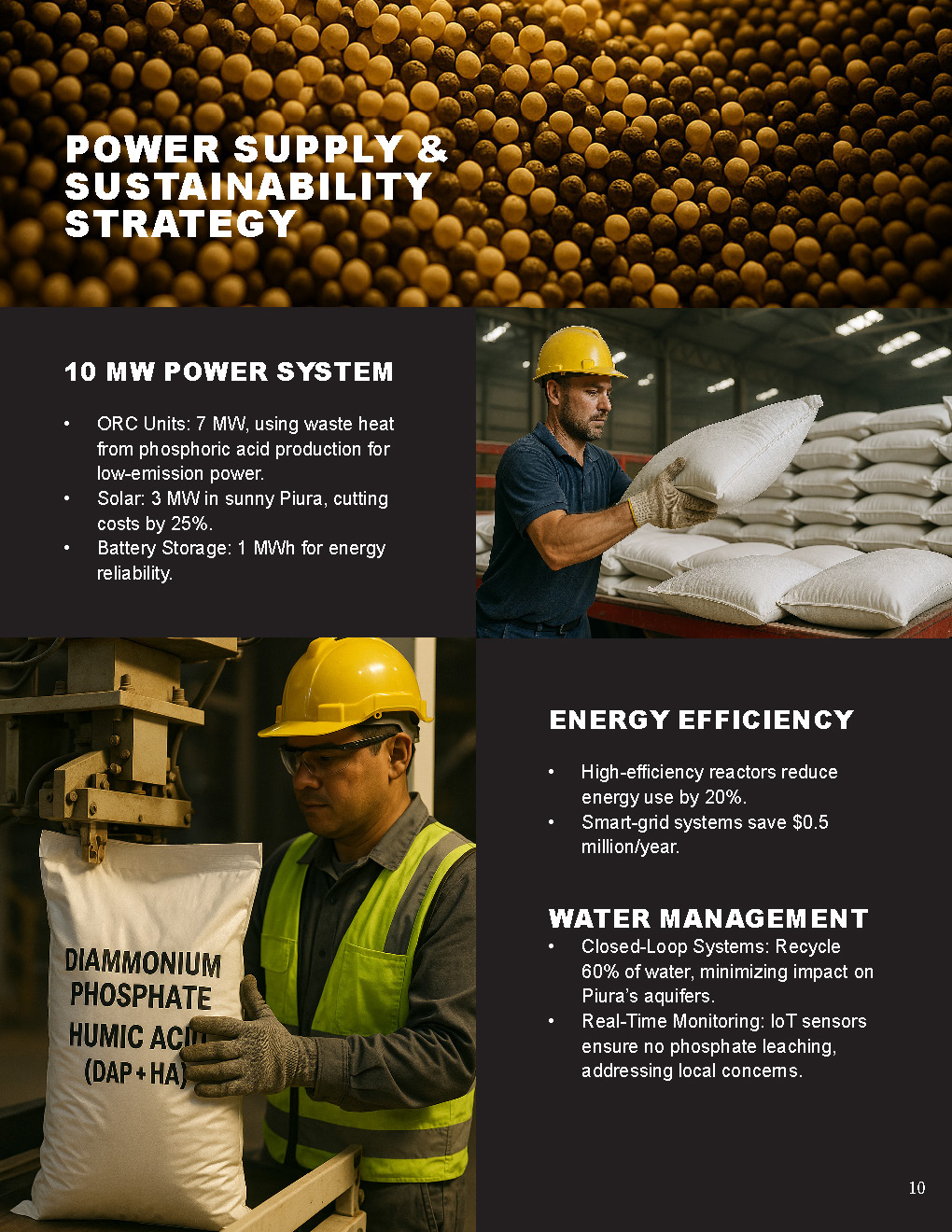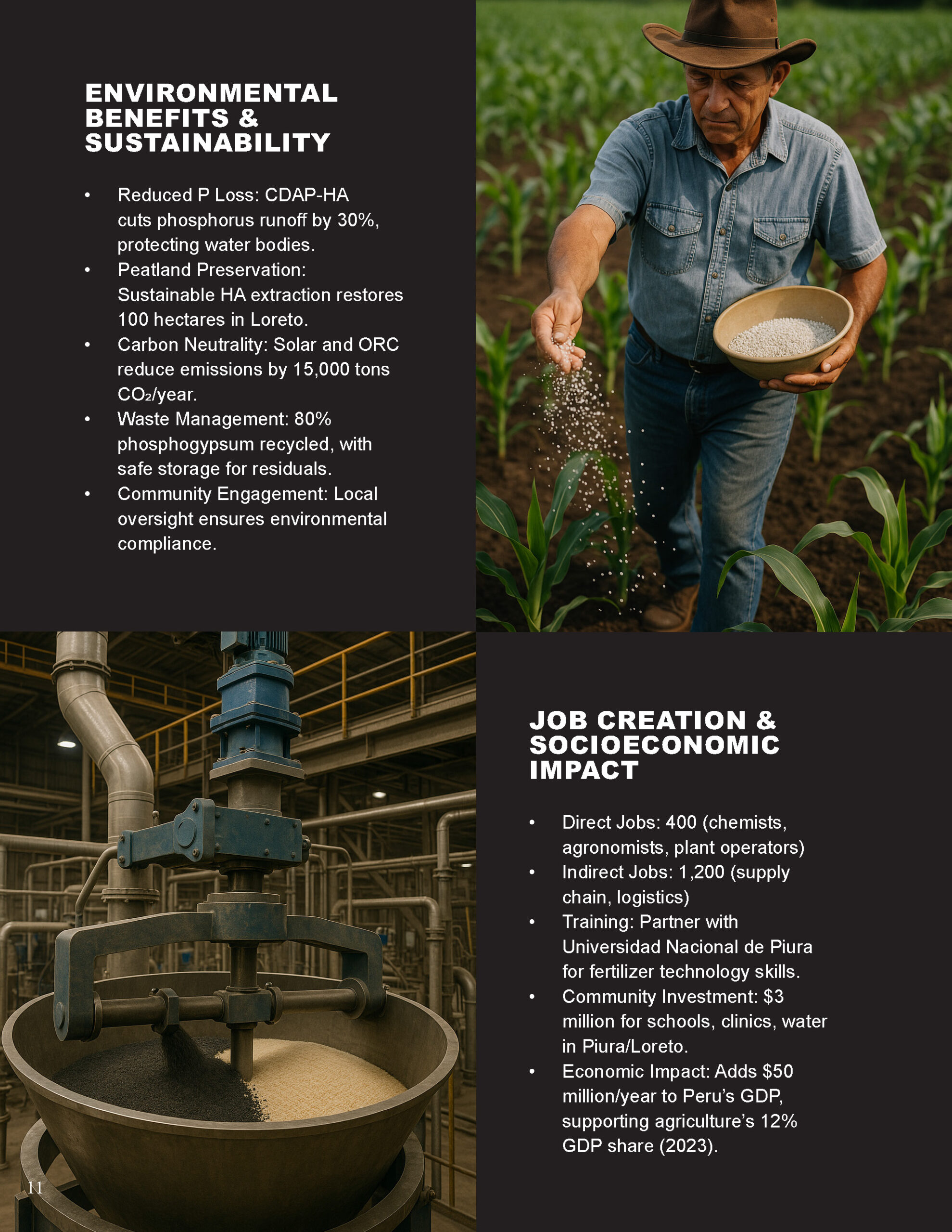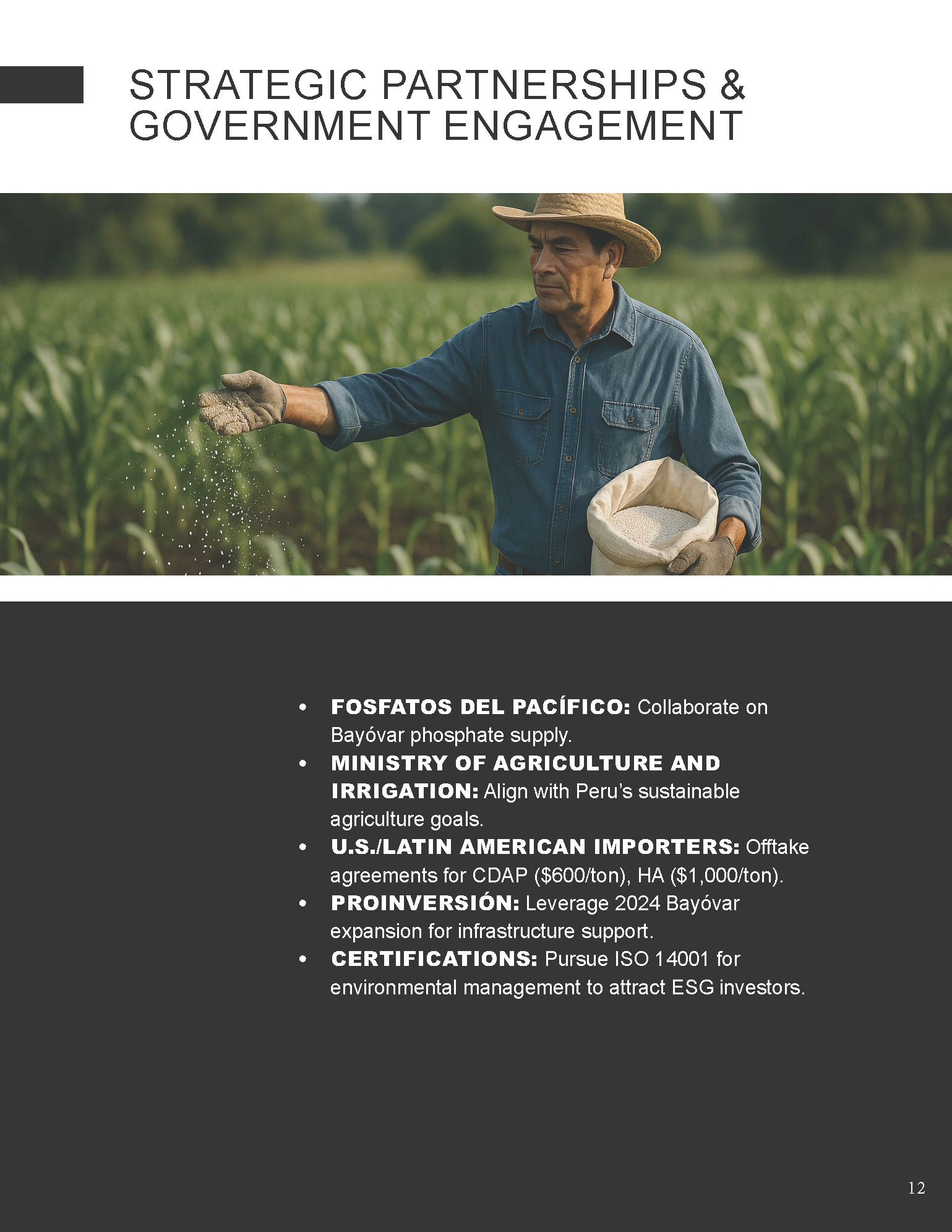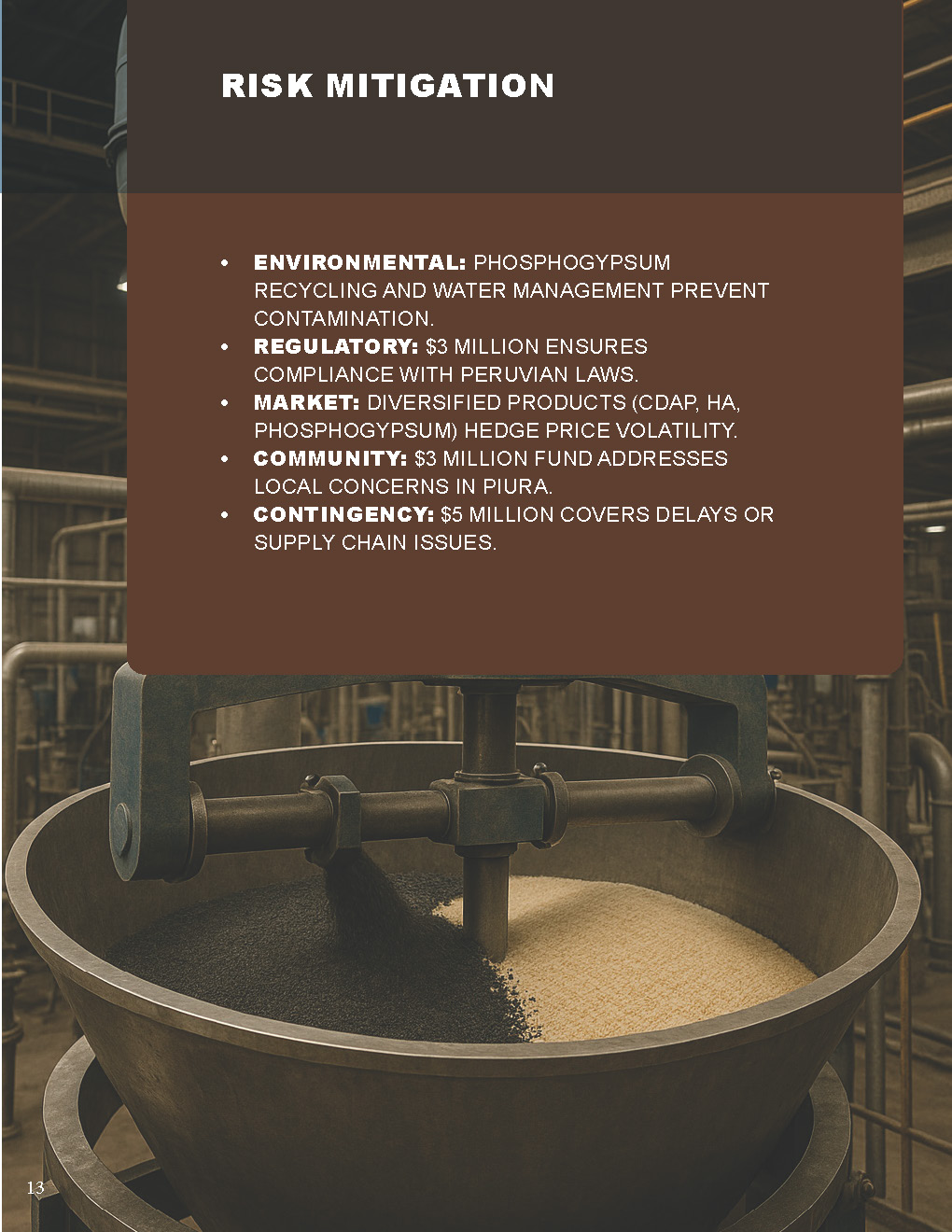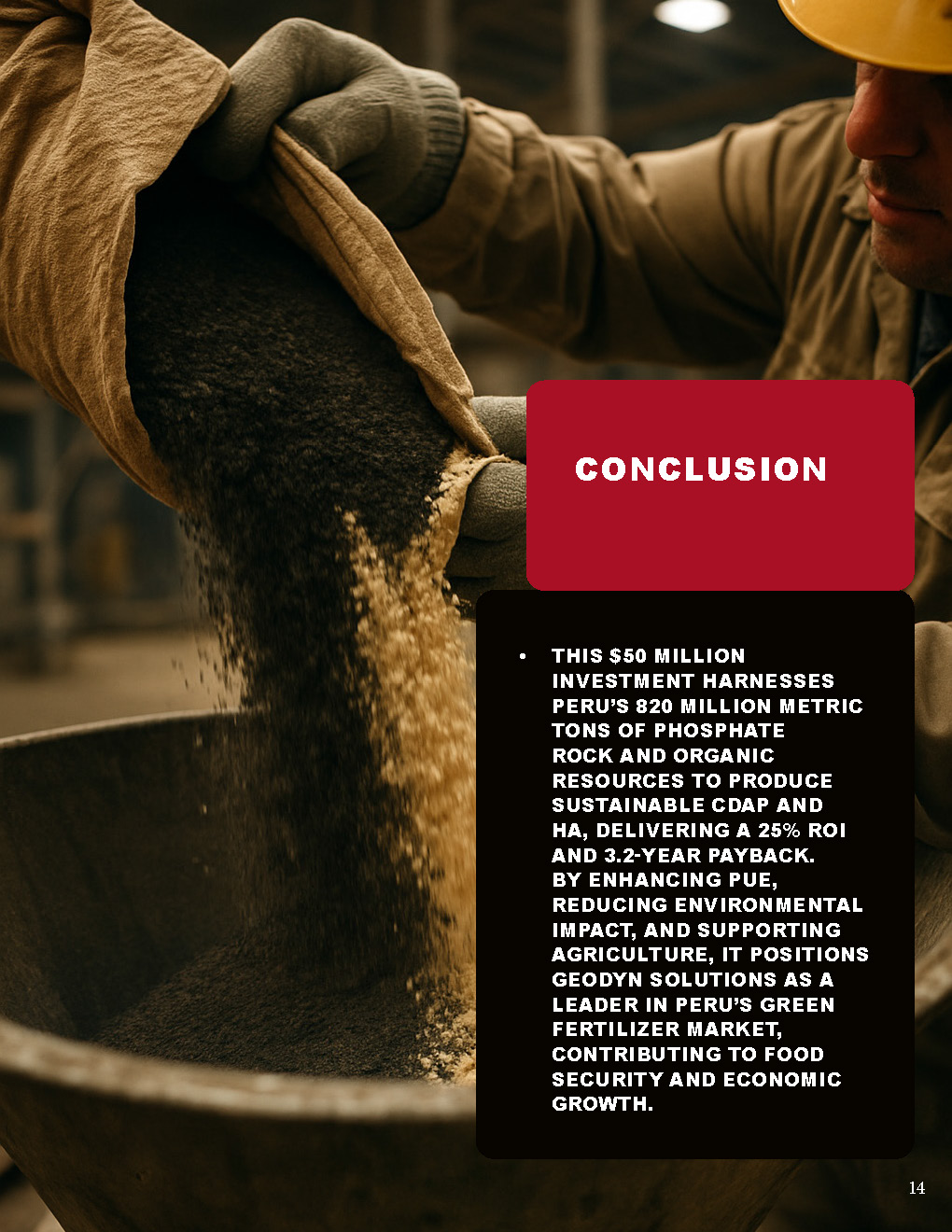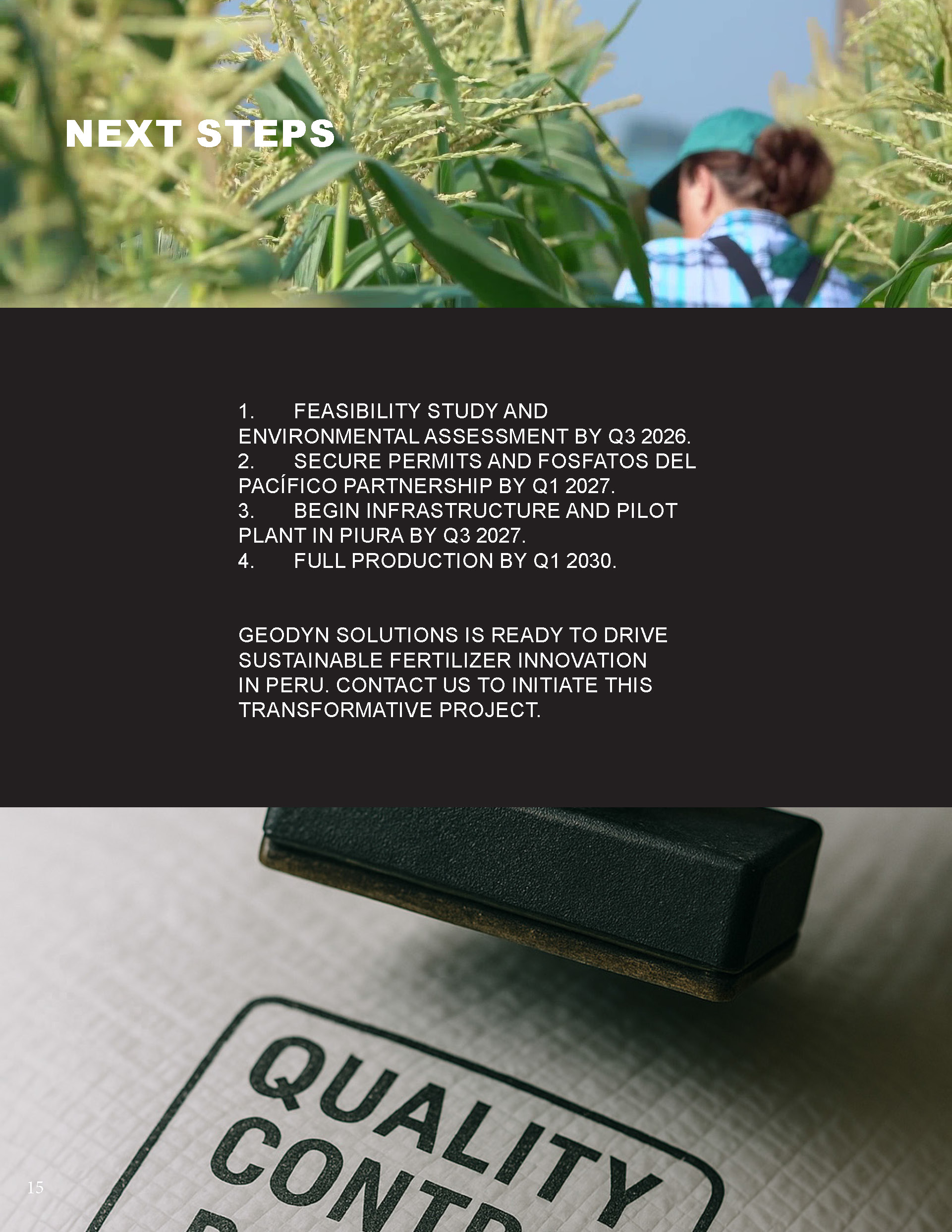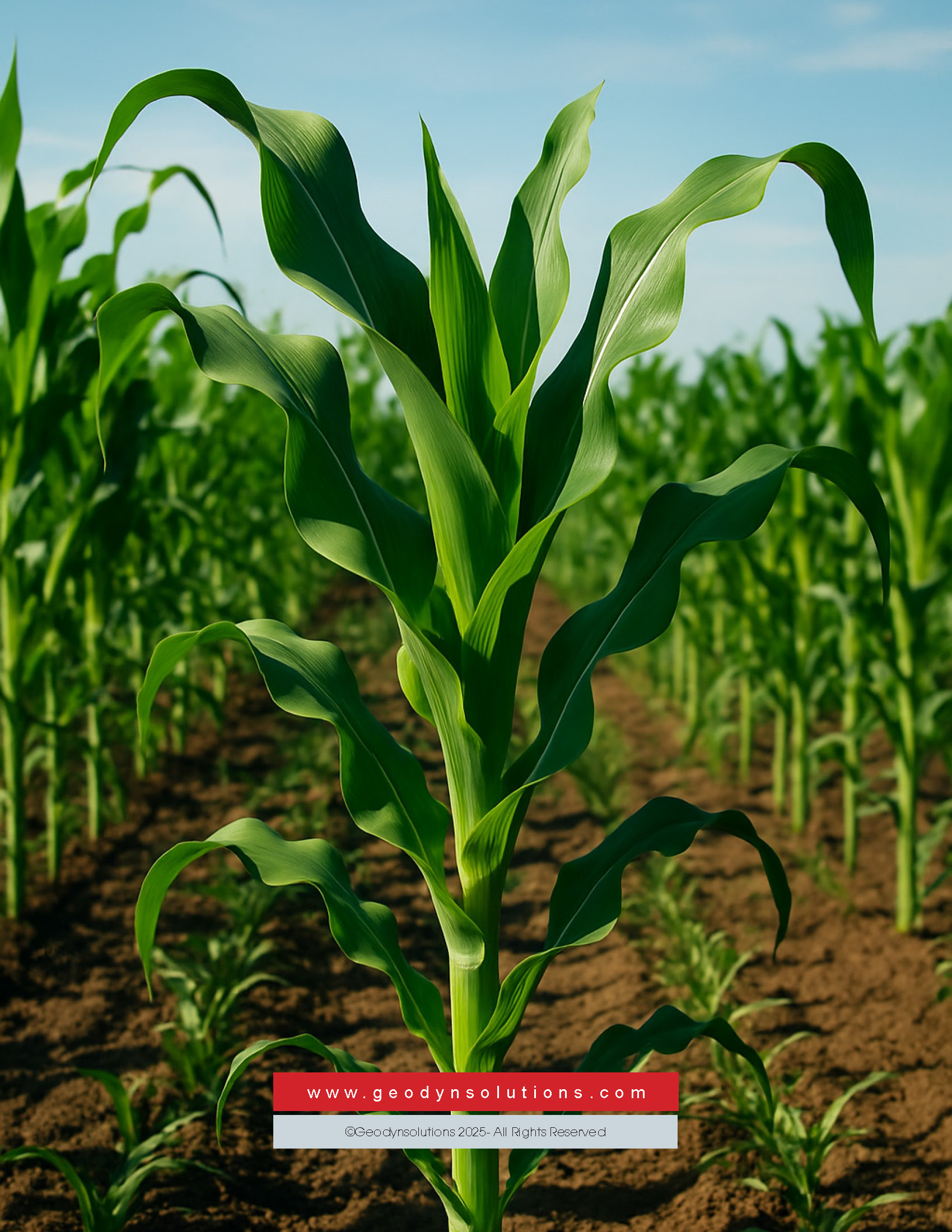Proposal for Geodyn Solutions: $50 Million Investment in Sustainable Diammonium Phosphate (DAP) and Humic Acid (HA) Project in Peru
Geodyn Solutions proposes a $50 million investment to establish a sustainable diammonium phosphate (DAP) and humic acid (HA) production facility in Peru, capitalizing on the country’s 820 million metric tons of phosphate rock reserves at the Bayóvar mine and organic-rich soils in the Amazonian Loreto region. The project integrates advanced eco-friendly technologies—controlled-release coated DAP (CDAP) production, humic acid-enhanced fertilizers, and phosphogypsum recycling—to improve phosphorus-use efficiency (PUE), reduce environmental impact, and boost agricultural yields. The investment includes $10 million for a 10 MW renewable power system (solar and Organic Rankine Cycle [ORC] units) and a $5 million contingency fund. With a projected ROI of 25% per annum and a payback period of 3.2 years, this initiative aligns with Peru’s agricultural export growth (e.g., coffee, cocoa), environmental regulations, and the 2024 $940 million Bayóvar expansion, positioning Geodyn as a leader in sustainable fertilizer production.
Investment Overview
- Total Investment: $50 million ($10 million for power generation, $5 million contingency fund)
- Project Duration: 8 years (5 years of peak production)
- Resources: 10 million metric tons of phosphate rock, 50,000 tons of humic acid from peat/soil
- Technology: CDAP production, HA extraction, phosphogypsum recycling, wet-process phosphoric acid production
- Annual Production Target: 100,000 tons of CDAP, 5,000 tons of HA, 50,000 tons of recycled phosphogypsum products
- Power Supply: 10 MW (7 MW ORC, 3 MW solar)
- Projected ROI: 25% per annum
- Payback Period: 3.2 years
- 8-Year Net Profit Projection: $1.1 billion
Resources in Peru
- Phosphate Rock: Peru holds 820 million metric tonsof reserves, primarily at the Bayóvar mine in Piura, producing 4 million metric tons annually (2023). 98% of U.S. phosphate imports come from Peru, with a $940 million expansion planned for 2024.
- Humic Acid Sources: Organic-rich Amazonian soilsand peatlands in Loreto, plus coastal guano deposits, provide abundant raw materials for HA extraction. Peatlands cover 50,000 km² in Peru’s Amazon, rich in humic substances.
- Agricultural Demand: Peru’s agriculture (coffee, cocoa, asparagus) drives fertilizer demand, with DAP imports supplementing local needs. HA enhances PUE, critical for acidic soils.
- Strategic Advantage: Proximity to Pacific ports and trade agreements (e.g., U.S.-Peru FTA) ensure efficient exports. Peru’s focus on sustainable agriculture supports green fertilizer projects.
Capital Expenditure (CAPEX)
- Exploration & Resource Assessment: $6 million (phosphate rock quality analysis, HA soil/peat mapping in Piura/Loreto)
- Processing Equipment: $15 million (wet-process phosphoric acid plant, CDAP coating systems, HA extraction units)
- Infrastructure (Roads, Water, Storage): $7 million (access roads, closed-loop water systems, storage facilities)
- Research & Development: $4 million (CDAP-HA formulations, phosphogypsum recycling)
- Regulatory Compliance & Licensing: $3 million (permits, environmental assessments per Peruvian laws)
- Environmental Protection & Restoration: $5 million (peatland restoration, phosphogypsum management)
- 10 MW Power System (ORC & Solar): $10 million (7 MW ORC, 3 MW solar)
- Contingency Fund: $5 million
- Total CAPEX: $50 million
Operational Costs (OPEX) & Revenue Projections
Annual OPEX Breakdown:
- Labor & Workforce: $4 million (400 direct jobs: engineers, chemists, agronomists)
- Energy Costs (ORC & Solar): $2 million (reduced by solar efficiency)
- Processing Operations: $6 million (phosphoric acid, CDAP, HA production)
- Logistics & Transportation: $2 million (exports to U.S./Latin America)
- Equipment Maintenance: $2 million
- Environmental Compliance: $1 million
- Total Annual OPEX: $17 million
Revenue Projections:
- CDAP: 100,000 tons at $600/ton = $60 million (reflecting 2023 DAP price trends)
- Humic Acid: 5,000 tons at $1,000/ton = $5 million
- Recycled Phosphogypsum Products: 50,000 tons at $100/ton (e.g., cement additives) = $5 million
- Total Annual Revenue: $70 million
- Annual Profit (after OPEX): $70 million – $17 million = $53 million
- 8-Year Net Profit (after 25% taxes/royalties): $1.11 billion
ROI and Payback Period
- Annual ROI Calculation:
- Net profit: $53 million × 0.75 (after 25% taxes/royalties) = $39.75 million
- ROI = ($39.75 million / $50 million) × 100 = 25% per annum
- Payback Period:
- Cumulative profit: $39.75 million/year
- $50 million ÷ $39.75 million ≈ 2 years
- Profit Post-Payback: $39.75 million × (8 – 3.2) = $190.8 million(years 4–8)
Eco-Friendly Technologies
The project employs sustainable technologies to enhance PUE, yield, and environmental responsibility:
- Controlled-Release Coated DAP (CDAP):
- Process: Phosphate rock is reacted with sulfuric acid to produce phosphoric acid, then neutralized with ammonia to form DAP. A polymer coating creates CDAP, releasing phosphorus based on plant demand.
- Benefits: Increases maize yield and PUE by 65% and 7.72%vs. standard DAP, reduces P loss by 30%.
- Economy: Higher market price ($600/ton vs. $550/ton for DAP) and lower environmental costs boost margins.
- Humic Acid (HA) Integration:
- Process: HA is extracted from Loreto peatlands using alkaline solutions (e.g., sodium hydroxide), then blended with CDAP at 5% (5 kg HA per 100 kg CDAP).
- Benefits: Reduces P fixation, improves soil P availability, and enhances maize yield by 7–9%. Buffers acidic DAP effects, protecting soil microbes.
- Economy: Allows 10–15% DAP reduction, saving $50–75/ton, offsetting HA costs.
- Phosphogypsum Recycling:
- Process: Phosphogypsum (5 tons per ton of phosphoric acid) is treated with lime and polyacrylamide for use in cement, soil amendments, or construction.
- Benefits: Reduces waste (Peru generates 20 million tonsannually), mitigates heavy metal leaching, and creates revenue.
- Economy: $100/ton for recycled products adds $5 million/year.
Advantages
- Yield: CDAP-HA increases crop yields by 10–15%, meeting Peru’s agricultural demand.
- Environmental: Non-toxic processes, 60% water recycling, and phosphogypsum reuse align with Peru’s environmental laws.
- Economic: 20% lower waste costs, high-value CDAP/HA products enhance revenue.
- ROI Boost: Sustainable technologies and diversified products drive 25% ROI, vs. 10–15% for traditional DAP plants.
Power Supply & Sustainability Strategy
10 MW Power System
- ORC Units: 7 MW, using waste heat from phosphoric acid production for low-emission power.
- Solar: 3 MW in sunny Piura, cutting costs by 25%.
- Battery Storage: 1 MWh for energy reliability.
Energy Efficiency
- High-efficiency reactors reduce energy use by 20%.
- Smart-grid systems save $0.5 million/year.
Water Management
- Closed-Loop Systems: Recycle 60% of water, minimizing impact on Piura’s aquifers.
- Real-Time Monitoring: IoT sensors ensure no phosphate leaching, addressing local concerns.
Environmental Benefits & Sustainability
- Reduced P Loss: CDAP-HA cuts phosphorus runoff by 30%, protecting water bodies.
- Peatland Preservation: Sustainable HA extraction restores 100 hectares in Loreto.
- Carbon Neutrality: Solar and ORC reduce emissions by 15,000 tons CO2/year.
- Waste Management: 80% phosphogypsum recycled, with safe storage for residuals.
- Community Engagement: Local oversight ensures environmental compliance.
Job Creation & Socioeconomic Impact
- Direct Jobs: 400 (chemists, agronomists, plant operators)
- Indirect Jobs: 1,200 (supply chain, logistics)
- Training: Partner with Universidad Nacional de Piura for fertilizer technology skills.
- Community Investment: $3 million for schools, clinics, water in Piura/Loreto.
- Economic Impact: Adds $50 million/year to Peru’s GDP, supporting agriculture’s 12% GDPshare (2023).
Strategic Partnerships & Government Engagement
- Fosfatos del Pacífico: Collaborate on Bayóvar phosphate supply.
- Ministry of Agriculture and Irrigation: Align with Peru’s sustainable agriculture goals.
- S./Latin American Importers: Offtake agreements for CDAP ($600/ton), HA ($1,000/ton).
- ProInversión: Leverage 2024 Bayóvar expansion for infrastructure support.
- Certifications: Pursue ISO 14001 for environmental management to attract ESG investors.
Risk Mitigation
- Environmental: Phosphogypsum recycling and water management prevent contamination.
- Regulatory: $3 million ensures compliance with Peruvian laws.
- Market: Diversified products (CDAP, HA, phosphogypsum) hedge price volatility.
- Community: $3 million fund addresses local concerns in Piura.
- Contingency: $5 million covers delays or supply chain issues.
Conclusion
This $50 million investment harnesses Peru’s 820 million metric tons of phosphate rock and organic resources to produce sustainable CDAP and HA, delivering a 25% ROI and 3.2-year payback. By enhancing PUE, reducing environmental impact, and supporting agriculture, it positions Geodyn Solutions as a leader in Peru’s green fertilizer market, contributing to food security and economic growth.
Next Steps
- Feasibility study and environmental assessment by Q3 2026.
- Secure permits and Fosfatos del Pacífico partnership by Q1 2027.
- Begin infrastructure and pilot plant in Piura by Q3 2027.
- Full production by Q1 2030.
Geodyn Solutions is ready to drive sustainable fertilizer innovation in Peru. Contact us to initiate this transformative project.
